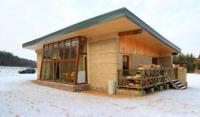House made out of earth by the scientists from the Faculty of Architecture
On 7th December 2012, in the Eco-Park in Pasłęk there was a grand ceremony of putting into use a research building made of earth. The authors of the project are employed at WUT’s Faculty of Architecture. These are Prof. Teresa Kelm, Mr. Jerzy Górski PhD and Mr. Marek Kołłątaj.
The Polish Press Agency interviewed Prof. Teresa Kelm, who said that it is the first building made of rammed earth in Poland. It is an ancient building method that has seen a revival in recent years as people seek more sustainable building materials and natural building methods. Earlier there were only attempts of filling the wooden constructions with mudbricks.
She added that the rammed-earth structures are thought to be more sustainable and environmentally friendly than popular building techniques. This kind of building is developing rapidly in temperate climates and recently became fashionable in Western Europe. There are about six thousand companies which produce building materials from earth.
The construction began in Spring 2007. The designing and building process were facilitated by the funding from the Ministry of Science and Higher Education in years 2005 – 2008. The entire cost of the project was 247 thousand zł. from which Pasłęki district was granted 67 000 zł. It was awarded with the Outstanding Buildings Award in 2011.
The compressive strength of rammed earth can be up to 4.3 MPa (620 psi). This is less than that of concrete, but more than strong enough for use in domestic buildings. Indeed, properly built rammed earth can withstand loads for thousands of years, as many still-standing ancient structures around the world attest to. One of the significant benefits of rammed earth is its high thermal mass; like brick or concrete construction, it can absorb heat during the day and release it at night. This moderates daily temperature variations and reduces the need for air conditioning and heating.
The scientists from WUT are currently researching the conditions of the building whilst in use e.g its temperature, humidity and lighting of the interior.
The building belongs to the city and region of Pasłęk and is used for sport, leisure, and other activities.







